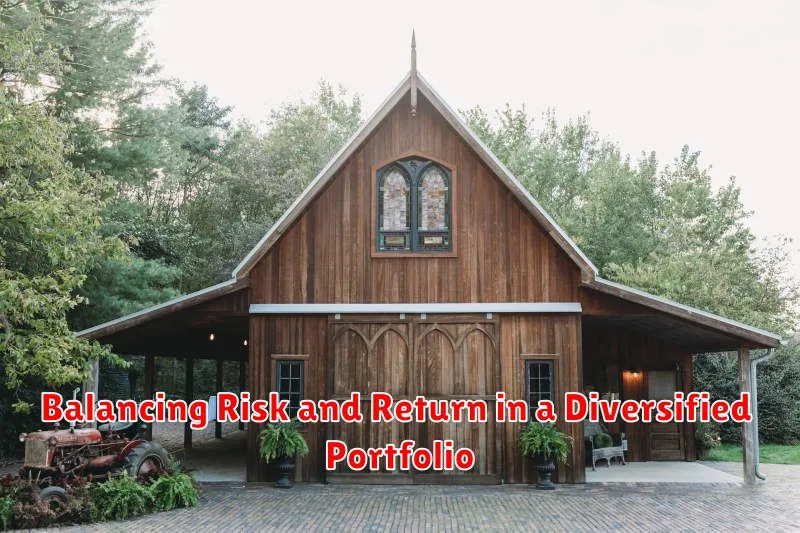Building wealth through real estate can be a powerful strategy, but it’s crucial to diversify your investments for optimal returns and risk mitigation. Diversification in real estate involves spreading your investments across various asset classes, locations, and property types, creating a balanced and resilient portfolio. By adopting a diversified approach, you can reduce your exposure to market fluctuations, maximize your potential for growth, and secure your financial future.
This article will delve into the fundamental strategies for building a diversified real estate portfolio. From exploring different property types and geographic markets to understanding the benefits of both direct and indirect investments, we’ll equip you with the knowledge and insights to make informed decisions. Whether you’re a seasoned investor or just starting, understanding the power of diversification is essential for building a robust and profitable real estate portfolio.
The Importance of Real Estate Portfolio Diversification
Just like a well-balanced stock portfolio, a diversified real estate portfolio is key to building wealth and mitigating risk. By spreading your investments across various property types, locations, and rental strategies, you can create a more resilient portfolio that can weather market fluctuations and economic downturns.
Here’s why real estate portfolio diversification is crucial:
- Reduces Risk: By investing in different property types and locations, you’re less vulnerable to market fluctuations in any single area. For example, if the rental market in one city weakens, the performance of your other properties in different regions may offset the losses.
- Increases Income Streams: Diversification allows you to generate income from a variety of sources. Investing in residential rentals, commercial properties, or even short-term vacation rentals provides you with multiple income streams that can balance each other out.
- Enhances Long-Term Growth: A diversified portfolio provides exposure to different market segments, increasing the potential for long-term growth. You can capitalize on trends in various sectors, like the demand for urban living, suburban housing, or commercial spaces.
- Improves Liquidity: Having a diverse portfolio with properties in different markets can improve your overall liquidity. If you need to access funds quickly, you have more options to sell a property without significantly impacting the performance of your entire portfolio.
By prioritizing diversification, you can build a more robust and sustainable real estate portfolio that can weather economic storms and generate consistent returns over the long term. Remember, a balanced and diversified portfolio is the cornerstone of successful real estate investing.
Assessing Your Current Portfolio and Risk Tolerance
Before embarking on diversification strategies, it’s crucial to understand your current real estate portfolio and risk tolerance. This involves a thorough assessment of your existing investments, their performance, and your comfort level with potential risks.
Inventory your current holdings. List all properties you own, including their purchase price, current market value, and any outstanding debt. Analyze the types of properties you own (e.g., single-family homes, multifamily units, commercial properties), their location, and their current performance.
Evaluate your risk tolerance. How comfortable are you with the potential for losses or fluctuations in property values? Are you seeking high returns with greater risk or lower returns with more stability? Understanding your risk tolerance helps guide your diversification decisions.
Assess your financial resources. Do you have the available capital for new investments? What is your debt-to-equity ratio? These factors will affect your ability to diversify your portfolio effectively. A strong understanding of your current financial situation will set the foundation for informed investment decisions.
Diversifying by Property Type: Exploring Your Options
Diversifying your real estate portfolio by property type is a crucial strategy for mitigating risk and maximizing returns. By investing in a mix of different property types, you spread your investment across various sectors, potentially reducing the impact of any single market downturn. Here are some popular property types to consider:
Residential Real Estate: This includes single-family homes, townhouses, and apartments. It’s typically a stable investment, offering consistent rental income and potential appreciation. You can further diversify within this category by targeting different price points, locations, and property sizes.
Commercial Real Estate: This encompasses office buildings, retail spaces, and industrial properties. While it can offer higher returns, it typically involves higher investment amounts and potential for higher risk. Different commercial property types cater to specific industries and economic sectors, allowing for further diversification.
Mixed-Use Properties: These combine residential and commercial spaces, offering a balance of income streams. They are becoming increasingly popular in urban areas, catering to the growing demand for mixed-use developments.
Vacant Land: This can be an opportunistic investment, particularly in areas with anticipated growth or development. However, it also involves a longer-term horizon and requires careful due diligence regarding zoning and permitting.
Specialty Property: These include unique properties like hotels, student housing, and senior living facilities. While they can offer niche opportunities, they often require specialized expertise and knowledge of the specific market.
Ultimately, the ideal mix of property types for your portfolio will depend on your individual financial goals, risk tolerance, and market knowledge. Consulting with a qualified real estate professional can help you make informed decisions and create a diversified portfolio that aligns with your objectives.
Geographic Diversification: Expanding Your Investment Horizons
Geographic diversification in real estate involves spreading your investments across different locations, reducing risk and maximizing potential returns. By investing in properties in various cities, states, or even countries, you mitigate the impact of local economic fluctuations or market downturns. For example, if one region experiences a decline in property values, your investments in other areas can potentially offset those losses.
Furthermore, geographic diversification allows you to tap into diverse market dynamics. Different locations offer unique investment opportunities based on factors such as population growth, job creation, infrastructure development, and government policies. By investing in areas with strong economic fundamentals and growth potential, you can enhance your overall portfolio performance.
Investing in geographically diverse locations also provides exposure to different rental markets. This can be particularly beneficial if you’re pursuing a rental income strategy. By diversifying your rental properties across various regions, you can potentially mitigate the risk of vacancies or low rental yields in any single market.
Diversification Strategies: Short-Term vs. Long-Term Rentals
Diversifying your real estate portfolio is key to mitigating risk and maximizing returns. One way to diversify is by exploring different rental strategies: short-term rentals and long-term rentals. Each offers unique advantages and drawbacks, so understanding their nuances can help you make informed decisions for your portfolio.
Short-term rentals, often managed through platforms like Airbnb and Vrbo, provide high-frequency income streams, potentially generating higher revenue than traditional long-term leases. However, they also involve higher management overhead, including cleaning, maintenance, and guest communication. Short-term rentals can be more susceptible to seasonal fluctuations and market volatility, requiring a proactive approach to pricing and marketing.
Long-term rentals, on the other hand, offer stable and predictable income streams with lower management burdens. While long-term leases typically generate lower monthly revenue than short-term rentals, they provide consistent cash flow and greater financial stability. Long-term rentals also benefit from lower tenant turnover, reducing vacancy periods and maximizing your return on investment.
The choice between short-term and long-term rentals ultimately depends on your individual investment goals, risk tolerance, and available resources. For example, if you’re seeking passive income and long-term stability, long-term rentals may be a better fit. But if you’re willing to manage higher turnover and volatility, short-term rentals can offer potentially higher returns.
Consider your location, target market, and desired level of engagement when making your decision. Researching local regulations, market trends, and competitor strategies can help you choose the rental strategy that aligns best with your overall real estate investment goals.
REITs and Crowdfunding: Alternative Diversification Avenues
While traditional real estate investments like purchasing individual properties offer potential for wealth building, they can also be illiquid and require significant capital. Fortunately, diversification within your real estate portfolio can be achieved through REITs (Real Estate Investment Trusts) and crowdfunding, providing access to a wider range of investment opportunities.
REITs are companies that own, operate, or finance income-producing real estate. They offer investors the opportunity to invest in a diversified portfolio of properties, such as shopping malls, office buildings, or apartments, without directly owning or managing them. REITs provide regular income streams through dividends, and their value can appreciate over time.
Crowdfunding, on the other hand, allows individual investors to pool funds together to finance real estate projects. This can range from commercial developments to residential properties. Crowdfunding platforms facilitate these investments, offering investors access to projects that might not have been available otherwise. This method can provide diversification by allowing investment in various real estate segments across different geographical locations.
Both REITs and crowdfunding present compelling avenues for diversification in your real estate portfolio. They offer access to a broader range of properties and markets, potentially reducing risk and increasing returns. However, like any investment, conducting thorough due diligence and understanding the associated risks before investing is crucial.
Balancing Risk and Return in a Diversified Portfolio

In real estate investing, like in any other investment domain, the fundamental principle of risk and return holds true. Higher returns often come with greater risk, and vice versa. Diversification, however, offers a strategic approach to navigate this delicate balance.
A diversified real estate portfolio, encompassing different asset classes and geographical locations, helps mitigate risk. By spreading your investments across various property types, such as residential, commercial, and industrial, you reduce the impact of market downturns in any single sector. Similarly, diversifying across different geographical regions helps you capitalize on local market growth while insulating yourself from potential economic slumps in specific areas.
While diversification helps manage risk, it’s equally crucial to consider your risk tolerance. Your investment goals and time horizon play a significant role in determining the appropriate risk level you’re comfortable with. If you seek higher returns, you might lean towards investments with higher risk profiles, such as developing properties or participating in real estate ventures. Conversely, if you prioritize stability and lower risk, you may favor established rental properties in established markets.
Remember, diversification isn’t about simply spreading your money around. It’s about making strategic decisions based on your unique circumstances and risk appetite. Thorough research, professional advice, and a well-defined investment strategy are essential for balancing risk and return in your diversified real estate portfolio.
Common Pitfalls to Avoid When Diversifying
Diversification is crucial for building a resilient real estate portfolio, but it’s easy to fall into common pitfalls. Understanding these traps is essential for avoiding costly mistakes and maximizing your investment returns.
Overdiversification: Spreading your investments too thinly across too many properties can lead to challenges managing them effectively and maximizing profits. Finding the right balance is key.
Ignoring Market Research: Diversifying without proper market research can lead to investments in areas with low demand or high competition. Thorough research helps identify promising markets with growth potential.
Lack of Risk Management: Diversifying across diverse property types can create a false sense of security. Implementing proper risk management strategies, like insurance and contingency planning, is crucial.
Emotional Investing: Making decisions based on emotions rather than data can lead to poor choices. It’s important to stick to your investment plan and resist impulsive buying.
Ignoring Location: Location is a critical factor in real estate success. While diversifying property types is valuable, prioritizing locations with high demand and appreciation potential is crucial.
By understanding these pitfalls and taking preventative measures, you can navigate diversification effectively and build a robust, profitable real estate portfolio.
Creating a Diversification Plan That Aligns with Your Goals

Diversification is a crucial strategy for building a robust real estate portfolio. It involves spreading your investments across different asset classes, locations, and property types. This approach helps mitigate risk and maximize potential returns. However, simply diversifying for the sake of diversification is not enough. A successful diversification plan must align with your financial goals and risk tolerance.
The first step is to clearly define your investment objectives. Do you aim for long-term capital appreciation, regular rental income, or a combination of both? Understanding your goals will guide your diversification choices. If you seek capital appreciation, you might prioritize properties in areas with high growth potential. For rental income, consider areas with a strong tenant pool and stable rental markets.
Next, consider your risk tolerance. How comfortable are you with potential fluctuations in property values? A higher risk tolerance might lead you to invest in emerging markets or niche property types. Conversely, a lower risk tolerance might favor established areas with stable rental demand.
Finally, assess your financial resources. Diversification requires capital. Set realistic investment budgets and allocate funds strategically. Consider using debt financing if necessary, but ensure it aligns with your overall financial plan.
By creating a diversification plan that aligns with your goals, risk tolerance, and financial resources, you can build a real estate portfolio that is both resilient and profitable.

